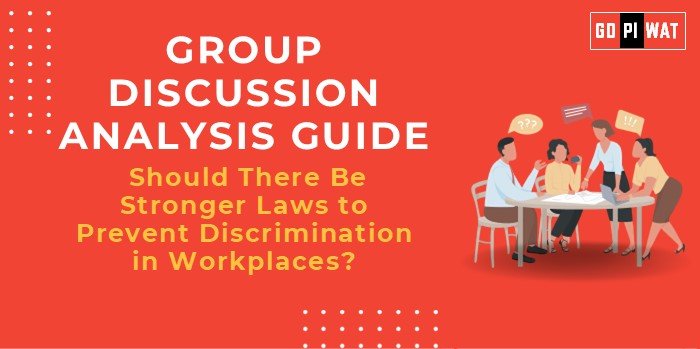📋 Group Discussion Analysis Guide: Should There Be Stronger Laws to Prevent Discrimination in Workplaces?
🌟 Introduction to the Topic
Opening Context: Workplace discrimination continues to undermine equality and inclusivity globally. Strengthened legislation could bridge gaps, promote fairness, and enhance productivity.
Background: Rooted in global labor movements and human rights declarations, workplace anti-discrimination laws aim to foster equitable environments. Yet, cases of gender, racial, and ability-based biases remain rampant in several sectors.
📊 Quick Facts and Key Statistics
- Global Cost of Workplace Discrimination: $1.7 trillion annually in lost productivity (ILO, 2023).
- Gender Pay Gap: Women earn 77% of men’s wages globally (World Economic Forum, 2023).
- Discrimination Complaints in India: 1,500+ cases reported to the National Human Rights Commission annually.
- Corporate Diversity Benefits: Companies with diverse leadership report 36% higher financial performance (McKinsey, 2023).
👥 Stakeholders and Their Roles
- Governments: Enforce stricter anti-discrimination laws and policies.
- Employers: Foster inclusive workplaces through transparent practices.
- Employees: Advocate for fair treatment and report violations.
- Civil Organizations: Monitor and support affected employees.
- International Bodies: Set standards, such as ILO conventions, and evaluate compliance.
🏆 Achievements and Challenges
Achievements:
- Legal Advancements: Equal Opportunity laws in countries like Norway and Canada.
- Diversity Programs: Global corporations, e.g., Google’s unconscious bias training, show measurable improvements.
- Increased Awareness: Movements like MeToo spotlight workplace inequities.
Challenges:
- Enforcement Gaps: Many laws lack proper execution mechanisms.
- Cultural Resistance: Deep-rooted biases hinder workplace transformation.
- Global Comparisons: The U.S. leads with strong anti-discrimination frameworks, while enforcement remains weaker in developing nations like India.
Case Studies:
- Norway’s Gender Quota Law: Raised women’s representation on boards to 40%.
- India’s Vishaka Guidelines: Landmark step against sexual harassment, though gaps remain in implementation.
🗣️ Structured Arguments for Discussion
- Supporting Stance: “Stronger laws are essential to ensure equitable opportunities and prevent systemic discrimination in workplaces.”
- Opposing Stance: “Excessive regulation may stifle business flexibility and innovation, imposing undue compliance burdens.”
- Balanced Perspective: “While robust laws are critical, fostering cultural change through awareness and education is equally important.”
🚀 Effective Discussion Approaches
- Opening Approaches:
- “Start with global statistics on workplace diversity and discrimination costs.”
- “Quote successful legal reforms, such as Norway’s quota system.”
- Counter-Argument Handling:
- Highlight enforcement mechanisms in countries with successful laws.
- Use examples of companies benefiting from diversity.
📈 Strategic Analysis of Strengths and Weaknesses
- Strengths: Boosts equity, compliance improves brand value.
- Weaknesses: Enforcement challenges, cultural resistance.
- Opportunities: Leverage technology for reporting and monitoring.
- Threats: Possible misuse of anti-discrimination laws for false allegations.
💼 Connecting with B-School Applications
- Real-World Applications: Case studies on workplace diversity programs, HR strategies for inclusivity.
- Sample Interview Questions:
- “How can businesses balance compliance with inclusivity?”
- “What lessons can India learn from global anti-discrimination frameworks?”
- Insights for Students: Use examples in HR management, public policy, and legal compliance projects.


